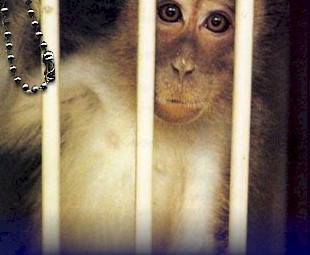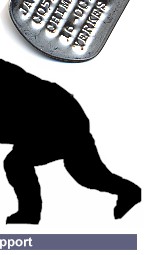






|
||||||||||||||||||||||||||||||||||||||||||||||||||||||||||||||||||||||||||||||||||||||||||||||||||||||||||||||||||||||||||||||||||||||||||||||||||||||||||||||||||||||||||||||||||||||||||||||||||||||||||||||||||||||||||||||||||||||||||||||||||||||
s93052 is a stump-tailed macaque,
a member of the species Macaca arctoides. These monkeys are
rarely used in research today although they are claimed to be good
models of male-patterned balding. s93052’s story is exceptional. He is one of the very few
monkeys ever to escape from a U.S. government-funded primate laboratory
with his life. s93052 was born on July 14, 1993 in Madison, Wisconsin, at the
University of Wisconsin-hosted Wisconsin Regional Primate Research
Center (WRPRC). Like other baby stump-tailed macaques, he was cream-colored
when he was born. Stump-tailed macaques mature more slowly than
do rhesus macaques and remain with their mothers for an extended
period. Like other macaques, these highly social animals live in
stable groups organized along matrilineages with social ranks transferred
from mother to daughter. Records kept by WRPRC on
individual animals are cryptic and sparse. Records state that
s93052’s mother was st0338 and his father was st0355. WRPRC
began using s93052 when he was 34 days old. He was assigned to a
project titled: Hair Growth in Juvenile. No details of the study
are known. On or about July 31, 1995, just after his second birthday, s93052
underwent his first skin biopsy. No reason for the biopsy is given
though it may have been a part of the Hair Growth study. Another skin biopsy was performed on October 18, another on November
27, and another on April 16, 1996. They noted that he had a wound
on a finger of his left hand that might have been infected. On June 25, and again on June 27, s93052 had two more skin biopsies. On July 9, 1996, a remark was made in s93052’s records that
he had diarrhea. Over the next 31 months, s93052 was reported with
diarrhea 113 times. “Diarrhea” is by far the most
frequent comment in his records. s93052 did not always have diarrhea. The primate center’s
veterinarians tested him for a variety of diarrhea-causing microorganisms
and began treating him. First with Flagyl, an antibacterial drug,
for six days, and then with Pepto-Bismol for another six days. Then
they tested him again for diarrhea-causing microorganisms but the
tests came back negative again so they gave him the antibiotic,
erythromycin, twice a day for seven days. Eleven days later, on September 24, 1996, the diarrhea returned
and was persistent. This time, treatment was not begun for some
time though many remarks (29 entries) concerning his illness were
entered into his records. On February 20, he had another skin biopsy. It was not until March 19, 1997 that treatment for the diarrhea
was resumed. Again, the lab results had come back negative. This
time, they treated him with enrofloxacin, a veterinary antibiotic,
and Pepto-Bismol every day for a week. Three days following his last dose, the diarrhea was back. On May 1, he had another skin biopsy and another on June 3, and
another on July 17. After another 37 comments about his diarrhea, more lab tests were
performed. Two amoeba species were identified: Iodamoeba butschlii
and Entamoeba coli. Both live happily in human intestines without
causing illness. On October 14, 1997, they began treating s93052 again. This time
with Pepto-Bismol alone, for six days. Two days later, the diarrhea
was back, and they put him back on the Pepto-Bismol. The pattern continued. A week of Pepto-Bismol, a day or two later,
more diarrhea. Then more Pepto, then more diarrhea. At the end of
one Pepto course, a note is made that he had “normal stool.
[G]ood response to peptobismol (sic) therapy.” The next entry:
“diarrhea.” On December 10, 1998, s93052 had a vasectomy. On January 6, 1999, after another Pepto-Bismol course, a note was
made: “Diarrhea gone – resolve case.” The next
entry is “diahrrea.” On January 11, “pulpotomies” were performed on all
four of s93052’s canine teeth. The Pepto-Bismol treatments, broken by bouts of diarrhea, continued
until February 23, 1999, at which point they started giving him
Flagyl again, and continued to do so until February 28, three days
before they shipped him to Texas and declared: “Feces consistency
normal – treatment complete – resolve.” From s93052’s records, we know that during the nearly six
years he was under WRPRCs control, he was chemically restrained
with Ketamine on 24 occasions and that he had at least 10 skin biopsies.
We cannot tell what his living arrangements were. Whether he was
caged with another monkey or caged alone, is undisclosed. We do
know that he had diarrhea for over two and a half years. The fact
that the specialists at WRPRC were unable to cure s93052’s
diarrhea suggests that their claims of curing human disease by studying
monkeys are unlikely to yield real results. If the extent of their
understanding of the physiology and pathology of a monkey results
in treating years of chronic diarrhea with Pepto-Bismol, then claims
of insight into HIV/AIDS and other human maladies must amount to
nothing. s93052’s move to Texas was a godsend. According to the sanctuary
director, s93052 now “resides happily at the National Sanctuary
for Retired Research Primates with 18 other stumptails. He has blossomed
into a beautiful male. He has had no medical problems since he has
been in with other stumptails in a large natural enclosure.”
Perhaps his diarrhea had been stress-induced by the highly unnatural
conditions monkeys are forced to endure in the labs. s93052, you have our best wishes. s93052’s story could not have been told without the efforts of Ms. Lori J. Korell, a Primate Freedom Tag wearer and primate advocate from Minnesota. Her efforts on behalf of s93052 have helped open the window into the daily lives and experiences of monkeys held in the nation’s premier primate laboratories.
Home Page | Our Mission | News |